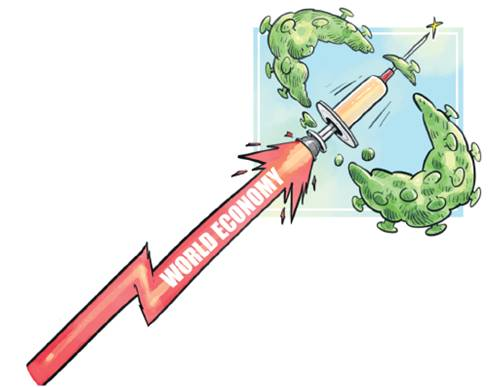Peking University, March 15, 2021: As the global economic growth rate may gradually converge to its long term trend level in the coming years, the catching-up of the Chinese economy is likely to continue in the future.

The novel coronavirus outbreak has caused the world economy to experience its biggest recession in nearly a century. Although the country's economic growth rate has been lower than its potential rate, thanks to its structural advantages and resilience, China is expected to become the only major economy to achieve positive growth in 2020.
With the progress of pandemic prevention and control and wide-scale vaccination programs, the world economy may recover in general in 2021. However, China's rapid catching-up is still expected to continue in the post-pandemic era.
According to the International Monetary Fund's October edition of Autumn World Economic Outlook report in 2020, the projected growth rate of the world economy in 2020 will be minus 4.4 percent, with the US economy expected to shrink by 4.3 percent and the Chinese economy predicted to grow by 1.9 percent. Converted to US dollars by market exchange rate, China's GDP was about 67 percent that of the United States in 2019, and reached 71 percent or more in 2020. In 2020, China's catch-up or convergence rate with the United States is more than 4 percent, which is significantly higher than the average rate from 2012 to 2019.
Although the spread of the novel coronavirus was on a large scale in China and severely impacted its economic operations at the beginning of 2020, thanks to the country's strong social mobilization capabilities and high execution abilities, the virus was largely brought under control relatively quickly, which created favorable conditions for the recovery of economy and the restoring of social order. In contrast, the US and other developed countries have not been able in bringing pandemics in control quickly and effectively as expected and their economic performances have been obviously affected. This is obviously the most important cause of the widening gap in economic growth between China and the US.
Judging from China's economic performance in the first three quarters in 2020, the effectiveness of its prevention and control measures not only laid the foundation for the earlier normalization of its economic and social order, but also for the recovery of its exports, foreign trade and overall growth.
After the World Health Organization announced a pandemic in last March, many thought that the great influence of the pandemic on demand would greatly drag down China's exports and so hinder its economic recovery.
In fact, although global demand has indeed shrunk sharply, due to the early recovery of China's economy to normal supply capacity, part of the demand in the international market has been transferred to China. Total exports grew by 1.8 percent in the first three quarters in 2020. The exports of notebook computers and home appliances increased by 17.6 percent and 17.3 percent respectively and the exports of textiles, including protective face masks, increased 37.5 percent.
Another factor for the positive performance of China's economy is related to the characteristics of China's stage of economic development and the sensitive response of its macroeconomy to the pro-active macroeconomic policies. In response to the impact of the epidemic at the beginning of the year, the central and local governments quickly introduced various recovery and stimulus policies. With the adjusted policy measures, different sectors of the macroeconomy soon responded.
For example, in the first three quarters in 2020, the added value of industrial enterprises above designated size increased by 1.2 percent year-on-year. Fixed asset investment increased by 0.8 percent year-on-year, of which infrastructure investment increased by 0.2 percent. Although the real estate sector faces various incremental regulations, the investment in this sector still achieved a relatively high growth rate of 5.6 percent, which played an important role in supporting the recovery of overall investment growth.
According to the projections of the mainstream international institutions, economies worldwide will generally recover to varying degrees in 2021, and the observed phenomenon of speeding up catch-up amid the global recession will no longer repeat as it has in 2020. However, based on the analysis of the medium-and long-term growth prospects and the driving factors of the Chinese, US and global economies, it is possible that China's economic catching-up may continue in the future.
For example, the IMF predicts that in 2021 the economic growth rate for China will be 8.1 percent and the US growth rate will be 3.5 percent, with the nominal GDP of the US and China's US dollar GDP growing by 5.36 percent and 10.98 percent respectively.
Under the new internal and external circumstances, complex influences will be derived from China's economic catch-up. Maintaining relatively rapid economic growth is necessary to achieve the goals of China's 14th Five-Year Plan (2021-25) and the long-range development objectives through till 2035. It will also resolve phased external environmental pressures. With the pandemic spurring innovation and fostering a broader concept of environmental protection and sustainable development, the world is also exploring and creating new development models that include effective prevention and response to new zoonotic diseases and new infectious diseases. This is helpful to promote global cooperation and alleviate international conflicts.
However, compared with the China's experience of rapid catching-up in the context of global economic prosperity at the beginning of the new century, the speeding up of the economy will face new challenges in the future. There is an increase in internal economic difficulties and the intensification of social contradictions in many countries, such as in the US and some European countries. China's accelerated catching-up and the increase in competitiveness in mid-to-high-end manufacturing and high-tech and emerging industries will introduce more uncertainty as the developed countries adjust their policies in response. China will need to deal with this firmly and calmly.
The author is Lu Feng, professor with the National School of Development at Peking University.
Source: China Daily